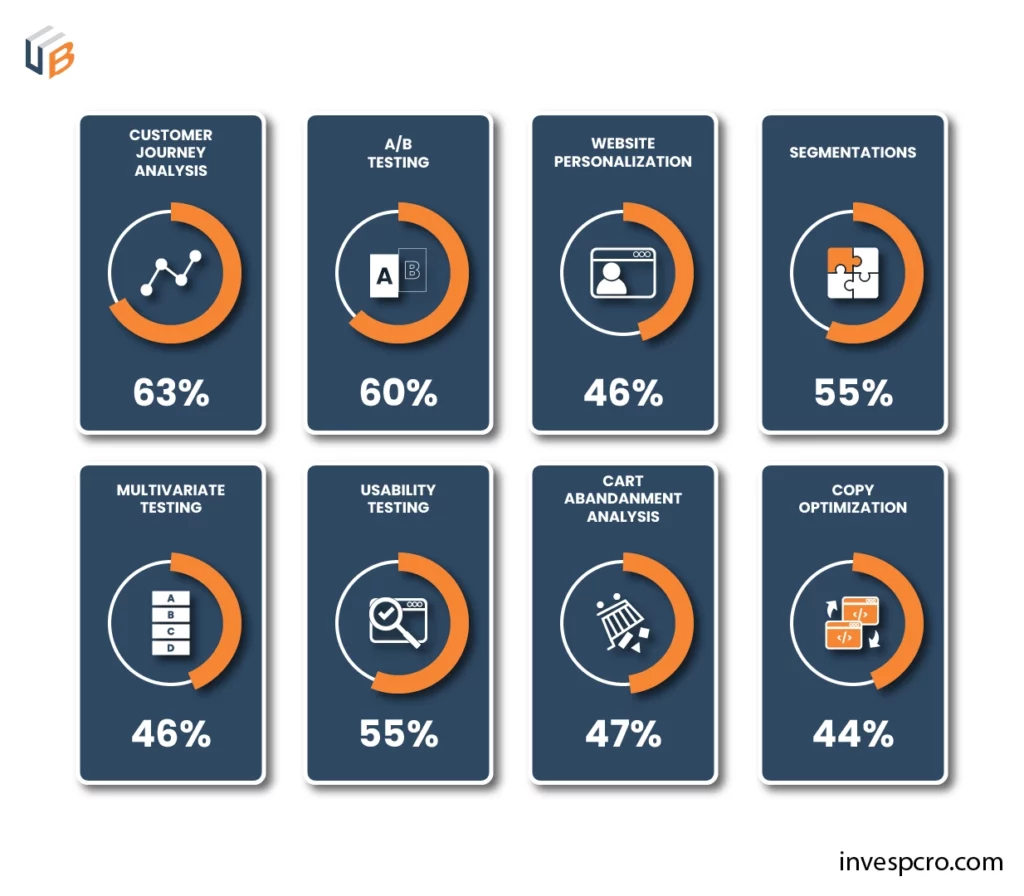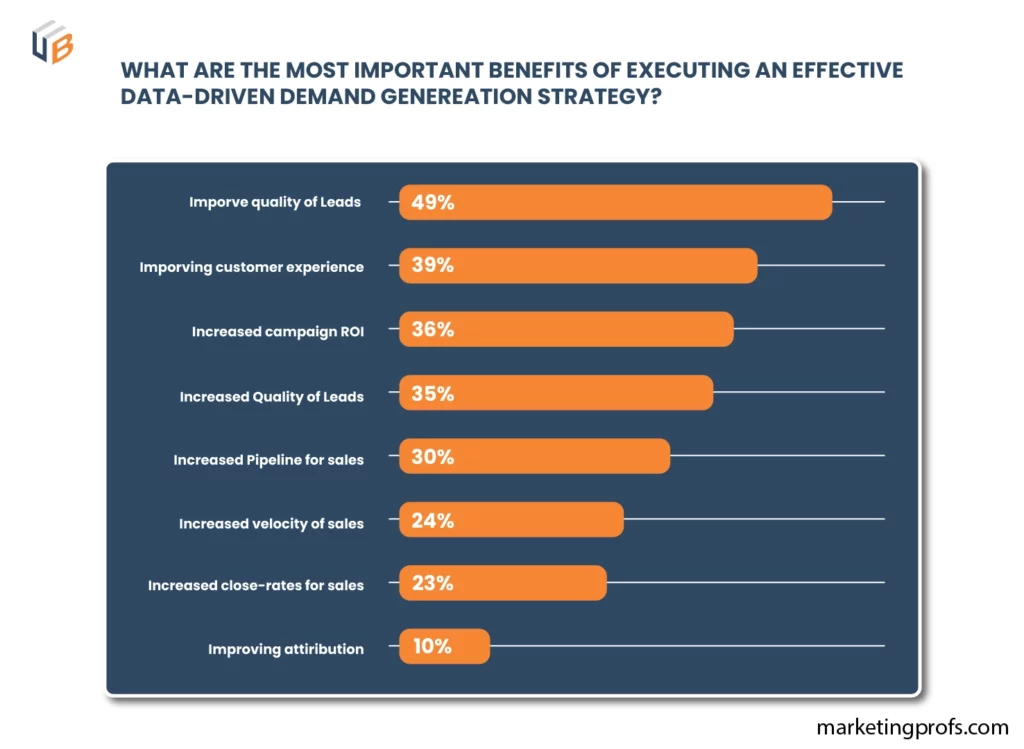
Introduction
As you already know, demand generation is more complex than lead generation. It requires multiple metrics, campaigns, and channels to drive maximum value from a demand generation strategy.
Though, it is not easy for marketing teams to keep an eye on several marketing metrics. But, more metrics mean more data, which will let you harness demand generation throughout the customer cycle.
Marketers today understand the value of data. According to the Invesp infographic, 64% of marketing executives strongly recommend that data-driven marketing campaigns are extremely important.
Moreover, marketers are using data in different demand marketing strategies, like:

Data-driven marketing is essential to achieving personalized and targeted growth. But, the question is how to leverage data into your demand generation strategy.
To find the answer to this question, simply scroll down and understand how you can use your valuable marketing data to design your result-driven demand gen strategy.
Why Should Marketers Use Data-driven Demand Generation Strategy?
Data is a base for marketing executives to decide and set their marketing goals. In addition, during demand generation planning, data is essential for selecting the right strategies for a business.
Demand gen has a complex mechanism. Demand generation strategies change and revive based on a lead’s position in the sales pipeline.
Therefore, marketers creating a demand marketing plan without data is like hitting an arrow in the dark. They don’t know whether their marketing campaign will deliver desired results.
So, to remove the guesswork and optimize marketing efforts, data is important.
Recently, Act-On and Ascend2 conducted a survey between January 17 to January 25, 2022, among 115 B2B professionals. This survey has shown how B2B marketing teams use more data than ever.
The respondents in the survey stated that data-driven marketing had increased lead quality, customer experience, camping ROI, sales pipeline, and more.

So, data is something that you cannot ignore today. For an effective demand generation strategy, data is your only anchor.
How to Create a Data-driven Demand Generation Strategy?
Demand generation is a multipurpose process. It not only helps to generate high-quality leads. But, it is also helpful to build a deeper connection with your targeted audience and create an authoritative brand image.
Thus, when you use data to create your demand generation strategy, you can better understand how your business goals are achieved.
According to a Gartner study, 32% of marketing executives find analytical and insightful marketing data as their number one lead generation factor in the last 18 months.
Now, by data, we don’t mean only your website traffic. No, marketing analytical data goes deeper and provides insightful information on various aspects of your potential customers’ online behavior. For example, it talks about what your customers are searching for online, what their preferences are at the moment, and so on.
So, how can I include data into my demand generation strategies?
There are several avenues where you can use data to develop your demand generation funnel. First, let’s explore in detail how to combine data and demand generation strategies.
1. Streamline sales and marketing teams
We have been talking about streamlining sales and marketing teams for a while now. But, in demand generation, a collaboration between your sales and marketing executives goes beyond creating an ideal customer persona.
Both marketing and sales data help to identify your marketing qualified, and sales qualified leads. You can better create your lead scoring system when you have real-time data from your marketing and sales departments.
Now, let’s take UnboundB2B as an example. We target B2B companies with an average employee base.
This is not sufficient data for us to launch a marketing campaign. We need more details to drive maximum value.
For example, we need information about:
- What have targeted customers’ pain points?
- Do we have the resources and technologies to resolve our customers’ problems?
- Which industry demands more lead generation services?
- On which channel our targeted customers are present?
There is a series of information required to create a lead qualification system. And for all this information, you need a seamless communication flow between your marketing and sales team.
This way, you can find the right data to create your demand generation strategy on time.
2. Automate your marketing process
Data-driven marketing is impossible without automation. Likewise, monitoring data across different marketing channels and resources is difficult without the right tools.
So, before creating demand-generation strategies using data, you should automate your entire marketing process.
You will be required to use various marketing tools to monitor your website traffic, social media engagement, digital ad performance, etc.
You can invest in the right analytical tools to monitor your campaigns based on your targeted marketing strategies.
According to Think with Google, marketing executives are using the following automatic marketing approaches:
- 3X marketing executives use automation to manage campaign budgets and bids across several marketing channels in real-time.
- 53% of marketing leaders are more likely to think that machine learning can help marketing teams to evaluate customer data based on their intent.
- 5X leaders will likely use digital data to create marketing campaigns and invest in the right marketing channels.
3. Nail your buyer persona
A buyer persona is a staple marketing strategy. Not only for demand gen. But to support all other marketing efforts, defining your buyer persona is a must.
The richer buyer’s persona you have, the stronger marketing campaigns you can create.
You need detailed data on your ideal customers for a deeper buyer persona. Simple demographical data is no longer enough to build an analytical buyer’s persona.
You can use intent data to understand your potential customers’ real-time preferences and interests. Data is further divided into three categories – first-party data, second-party data, and third-party data.
First-party intent data helps you know how visitors behave on your site, like which pages drive more traffic, where your website visitors click, etc.
On the other hand, second and third-party data tells what your buyers are searching on other websites and search engines.
Compiling buyer’s persona based on extensive data will allow you to practice account-based marketing.
You can design personalized marketing campaigns targeting your sales funnel. It will also enable you to nurture your hot leads rather than wasting time on cold leads.
You can here take inspiration from Salesforce. The company crafts personas using rigorous data and analysis. They analyze real users’ behaviors, desires, tools, and perspectives on Salesforce products within the context of their needs.
4. Set your KPIs
Key performance indicators are another crucial marketing component. KPIs help you align your demand gen strategies to your end marketing goals.
You can also determine the success of your marketing campaigns based on your preset KPIs.
There are endless ways to monitor your marketing data. But, the most important marketing KPIs that all digital businesses must monitor are:
Visitors
The number of visitors your website gets over a predetermined period is valuable data to start with. You need initial marketing data to know how many new visitors your website has acquired in a given period.
This helps you understand which page or content is getting more traffic on your site. Accordingly, you can better plan your content marketing strategies to generate demand.
Qualified leads
Most businesses make the mistake of only calculating their leads over time. But unfortunately, not all the leads that land on your website are a perfect fit for your business. Some leads are useless at this point.
Therefore, you should create a lead qualification system to weed out qualified leads. Further, categorize your qualified leads into different subgroups based on their readiness to convert.
For example, a lead on your pricing page is more qualified than a lead on your home page.
Opportunities
Opportunities are the metric that shows you people who are the right fit for your business. These people are interested in your business. You simply have to use personalized marketing strategies to convert them.
Conversion rates
This is the most important metric to know what percentages of people have moved from one stage to the next. This shows you whether your targeted leads moved upwards or downwards in your sales funnel.
5. Work on building trust
According to an Adobe study, 7 in 10 consumers will buy more from the brands they trust.
Thus, you must use data to build trust among your targeted audience. Using your buyer intent data, you can formulate the best plan to win your customers’ trust.
Here are some successful trust-building strategies for B2B businesses:
Free version or trial
B2B SaaS Companies often use this strategy to earn their customers’ trust. They provide a free version or trial of their premium products so that users can try and test their products.
When people find the product useful, they will not mind paying for it. This marketing strategy is used by pioneer SaaS companies.
For example, HubSpot provides a premium marketing dashboard. But to gain users’ trust, they offer a series of free tools like Website Grader, Make My Persona, etc.

Source : resources
Associate with a social cause
Another popular strategy to build customer trust is accepting your social responsibility. Consumers prefer companies that align their values and support social causes.
According to a report, 71% of consumers prefer to buy from companies that support a social cause. When you support a social cause, you connect with your customers on a personal level. It helps to build deeper relationships with your consumers.
For example, Grammarly supports the Ukrainian people. It has already donated $4.75 million to revive Ukraine and plans to donate more in the coming weeks.

Source : Grammarly
6. Use content to capture data
Content is the simple way to capture real-time user data. The way visitors interact with your content helps you to understand them.
For instance, when someone clicks on your blog post, it shows that they have a specific problem and are looking for its solution on your website. This doesn’t clear whether a person is aware of your business or ready to purchase.
On the contrary, when someone downloads an ebook from your website, this tells that they are familiar with your brand and interested in your services. But, they are not yet ready to make a purchase.
However, when a visitor clicks on the CTA mentioned on your blog, this means that the person is ready to purchase your services.
Therefore, you should publish various content on your website to understand your visitors’ preferences and collect valuable data.
Apart from your website, also publish content on third-party websites. You can use a content syndication method to collect user data from different marketing channels.
7. Refresh your data
Data gets stale too easily. Importantly, when your data subject is unpredictable as humans.
Consumer preferences change rapidly despite the industry. Thus, using your years-old data to create a demand generation strategy will be useless.
You need to set up a process where you can receive real-time customer data. For example, you can use data analytical tools to monitor your visitors’ behavior across your site.
Apart from collecting real-time data, it is also important to interpret it and implement quick solutions.
Many big companies failed because they could not interpret their customers’ feedback. Its prime example is Windows 8 failure.
Windows failed to understand its users’ intent from Windows Vista’s failure and launched Windows 8, borrowing the interface from Apple.
But, they realized their mistake and returned to traditional Windows outlook with the next two successful system updates.
Can You Create a Demand Generation Strategy Without Data?
No, it is impossible to create a demand generation strategy without data. You need data to understand your audience, and market gap, and define growth strategies.
Data is what empowers digital marketers to create high ROI-driven strategies.
So, always collect and analyze data in real-time while creating your marketing strategies.
Don’t know how to collect valuable data? Or don’t you have time to keep your database fresh?
In that case, we are here to help you. We have all the right tools and technologies to create data-driven marketing strategies. Let’s get started with your next data driven demand generation strategy today.
Our blog
Latest blog posts
Tool and strategies modern teams need to help their companies grow.

It is for fact that today's buying environment demands more. With longer sales cycles...

To build a marketing strategy that drives real results, you need more than creative i...

The 95/5 rule in B2B marketing shows that while only 5% of buyers are ready to purcha...







